Why is the Crescent the Symbol of Islam?
Islam, the world’s second-largest religion, has a rich history and a set of distinctive symbols that reflect its faith and teachings. One of the most recognizable symbols associated with Islam is the crescent. This symbol, commonly found on flags, buildings, and other Islamic representations, holds deep significance for Muslims around the world. In this blog post, we will explore the origins, meaning, and evolution of the crescent as the symbol of Islam.
The Historical Origins of the Crescent
The use of the crescent as a symbol can be traced back to long before the advent of Islam. The crescent moon has been recognized and revered by various ancient civilizations, including the Greeks and Romans, who associated it with their own deities.
In pre-Islamic Arabia, the crescent moon was an important symbol used by different tribes to represent their own gods and goddesses. With the emergence of Islam in the 7th century CE, the use of the crescent in Arabian culture took on a new significance.
The Connection to Islamic Traditions
The association of the crescent with Islam is often attributed to historical events and specific Islamic traditions. One commonly cited instance is the use of the crescent to mark the beginning of the lunar month, which forms the basis of the Islamic calendar. The sighting of the new crescent moon confirms the start of each month, including Ramadan, the holy month of fasting.
Additionally, the crescent is linked to the Islamic tradition of moon sighting during the month of Ramadan. Muslims observe the end of the fasting day by sighting the crescent moon, symbolizing the breaking of the fast.
Throughout history, Muslim astronomers and scientists made significant contributions to the study of celestial bodies. The visibility of the crescent moon was of particular interest to these scholars, as they sought to accurately determine the beginning and end of Islamic months. Their work solidified the crescent’s connection to the Islamic faith.
The Symbolism of the Crescent
The crescent holds various symbolic meanings within the context of Islam. One interpretation is that the crescent represents the cycle of life and nature, reflecting the constant rhythm of creation and renewal. Just as the moon waxes and wanes, Muslims believe in the cyclical nature of existence and the eternal renewal of the soul.
Moreover, the crescent holds a significant connection to the Prophet Muhammad. According to tradition, the night journey or Isra and Mi’raj, which occurred during Muhammad’s lifetime, is said to have been marked by a miraculous vision of the moon splitting into two crescents. This event holds great spiritual importance for Muslims, and the crescent symbolizes this divine experience.
Modern Usage of the Crescent
Over time, the crescent became increasingly associated with Islam, especially during the time of the Ottoman Empire. The Ottomans adopted the crescent as a prominent symbol, displaying it on flags, architecture, and military insignia. As the empire expanded its influence, the crescent became more widely recognized as an Islamic symbol.
Today, the crescent symbol is used by various Islamic organizations, countries, and communities to represent Islam. It can be seen on national flags, mosque domes, and even jewelry and clothing worn by Muslims worldwide. Furthermore, the crescent is often combined with a star, commonly known as the “star and crescent,” which further represents the Islamic faith.
Misconceptions and Controversies
Despite its ubiquity, the crescent as the symbol of Islam has sometimes been subject to misconceptions and controversies. Some critics have erroneously associated the symbol with negativity or portrayed it as an inherently militant or extremist emblem.
It is important to remember that the crescent, like any symbol, can have multiple interpretations and meanings. It is a representation of the Islamic faith and holds deep spiritual significance for Muslims. It is not intended to promote violence or any negative connotations often attached to it.
In Conclusion
The crescent has a rich historical background and holds significant meaning within the Islamic faith. Its association with the cycles of nature, Prophet Muhammad’s spiritual experience, and the advent of the Islamic calendar solidifies its symbolism in the hearts and minds of Muslims worldwide.
While the crescent may have ancient roots outside of Islam, it has evolved over time to become an unmistakable symbol of the faith. It serves as a reminder of the unique history, traditions, and beliefs of Muslims, encapsulating the beauty and diversity of the Islamic world.
As the world continues to embrace cultural diversity and foster greater understanding, it is crucial to recognize and respect the symbols and traditions that hold profound meaning for different communities. The crescent, as the symbol of Islam, is a testament to the depth and richness of a religion that spans continents and centuries.
Table of Contents
